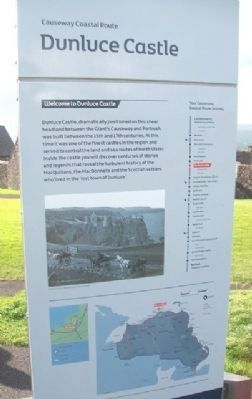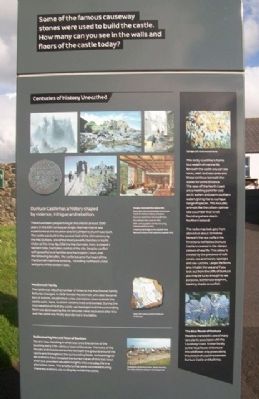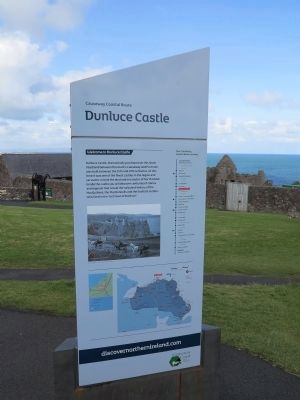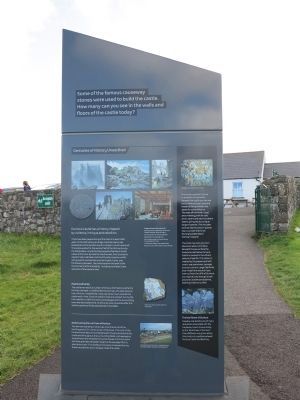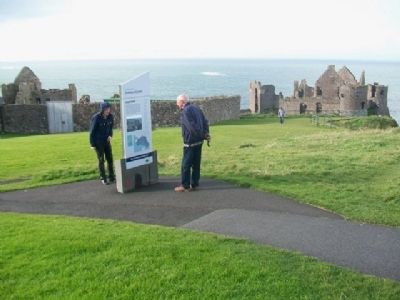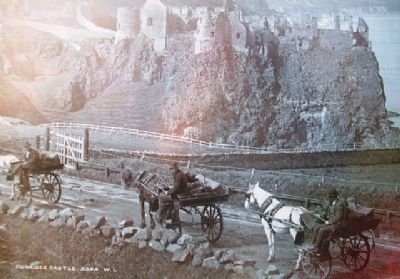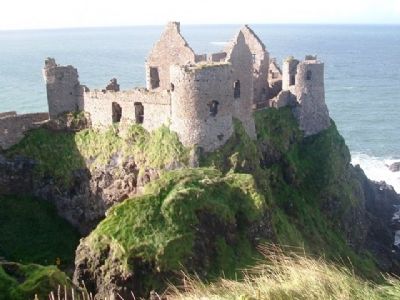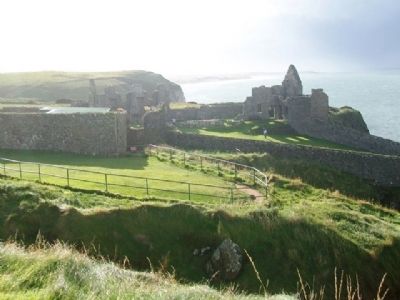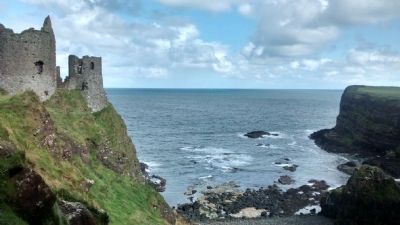Near Bushmills in Causeway Coast and Glens, Northern Ireland, United Kingdom — Northwestern Europe (the British Isles)
Dunluce Castle
Causeway Coastal Route
Side A
Welcome to Dunluce Castle
Dunluce Castle, dramatically positioned on this sheer headland between the Giant's Causeway and Portrush, was built between the 15th and 17th centuries. At this time it was one of the finest castles in the region and served to control the land and sea routes of North Ulster. Inside the castle you will discover centuries of stories and legends that reveal the turbulent history of the MacQuillans, the MacDonnells and the Scottish settlers who lived in the 'lost town of Dunluce'.
[Photo caption reads] Dunluce Castle c.1900
[Map and Causeway Coastal Route Journey linear locator]
Side B
Some of the famous causeway stones were used to build the castle. How many can you see in the walls and floors of the castle today?
Centuries of History Unearthed
Dunluce Castle has a history shaped by violence, intrigue and rebellion.
There have been people living at this site for at least 1500 years. In the 13th century an Anglo-Norman manor was established at this location and St Cuthbert's church was built. The castle was built in the second half of the 15th century by the MacQuillans, one of the most powerful families in North Ulster at this time. By 1556 the MacDonnells, from Scotland's western Isles, had taken control of the site. Despite conflict with powerful local families and the English Crown, over the following decades, the castle became the heart of the MacDonnell maritime lordship, including northeast Ulster and parts of the western Isles.
MacDonnell Family
The castle was rebuilt a number of times as the MacDonnell family fortunes changed. In 1608 Randal MacDonnell, who later became Earl of Antrim, established a new plantation town outside the castle walls. Here, Scottish settlers lived and worked. During the Irish rebellion of 1641 the castle was besieged and the surrounding town was destroyed by fire. Its fortunes never recovered after this and the castle was finally abandoned in the 1680s.
Images clockwise from above left:
Early 19th-century illustration of Dunluce Castle, Dunluce Castle from the shore, Excavating in the castle, 16th-century polish coin found during the excavations, Crossing the bridge to the castle, Reconstruction of life inside the castle
Early 17th-century Dutch tile found in the town
Rediscovering the Lost Town of Dunluce
You are now standing in what was once the centre of the bustling early 17th-century town of Dunluce. The ruins of the houses and streets are buried beneath the ground around the castle and throughout the surrounding fields. Archaeological excavations have revealed the buried traces of this lost town and have provided valuable insights into everyday life in a plantation town. The artefacts that were uncovered during these excavations are on display inside the castle.
[Photo caption reads] Excavations at Dunluce Town, clearly showing the wide cobbled roadway in the foreground.
This rocky coastline is home to a wealth of marine life. Beneath the castle you can see rocks, reefs and sea caves and these continue beneath the waves for some distance. The seas off the North Coast are a meeting point for cold arctic waters and warm southern waters giving rise to a unique range of species. This includes animals like the cotton-spinner sea cucumber that is not found anywhere else in Northern Ireland!
The rocks may look grey from above but about 10 metres beneath the sea surface the limestone reef below Dunluce Castle is covered in the vibrant colours of sea life. This colour is created by the presence of soft corals, sea anemones, sponges and sea-urchins. Larger life forms also inhabit the sea and if you look out from the cliffs of Dunluce you may be lucky enough to see porpoise, bottlenose dolphins, basking sharks or sunfish.
The blue flower of Dunluce
Meadow cranebill is one of many rare plants associated with the Causeway Coast. Known locally as the 'blue flower of
Dunluce' this wildflower only grows along this stretch of coastline between Dunluce Castle and Ballintoy.
Topics. This historical marker is listed in these topic lists: Environment • Forts and Castles • Settlements & Settlers. A significant historical year for this entry is 1900.
Location. 55° 12.627′ N, 6° 34.72′ W. Marker is near Bushmills, Northern Ireland, in Causeway Coast and Glens. Marker is on the grounds between the castle and car park. Touch for map. Marker is at or near this postal address: 87 Dunluce Road, Bushmills, Northern Ireland BT57 8UY, United Kingdom. Touch for directions.
Other nearby markers. At least 7 other markers are within 10 kilometers of this marker, measured as the crow flies. Bushmills History & Heritage (approx. 3.5 kilometers away); World Wars Memorial (approx. 3.5 kilometers away); Sgt. Robert Quigg (approx. 3.5 kilometers away); Giants Causeway and Bushmills Railway (approx. 3.5 kilometers away); Alphabet Angel (approx. 3.6 kilometers away); Hamill Terrace (approx. 3.7 kilometers away); Dunseverick Castle (approx. 8.8 kilometers away).
Also see . . .
1. Dunluce Castle, County Antrim. (Submitted on December 23, 2013, by William Fischer, Jr. of Scranton, Pennsylvania.)
2. 50 Things You Probably Never Knew About Dunluce Castle. (Submitted on December 23, 2013, by William Fischer, Jr. of Scranton, Pennsylvania.)
3. Dunluce Castle. Wikipedia article on Dunluce Castle (Submitted on November 4, 2014, by Richard Denney of Austin, Texas.)
Credits. This page was last revised on September 6, 2022. It was originally submitted on December 23, 2013, by William Fischer, Jr. of Scranton, Pennsylvania. This page has been viewed 779 times since then and 28 times this year. Photos: 1, 2. submitted on December 23, 2013, by William Fischer, Jr. of Scranton, Pennsylvania. 3, 4. submitted on November 4, 2014, by Richard Denney of Austin, Texas. 5, 6, 7, 8. submitted on December 23, 2013, by William Fischer, Jr. of Scranton, Pennsylvania. 9. submitted on November 4, 2014, by Richard Denney of Austin, Texas.
